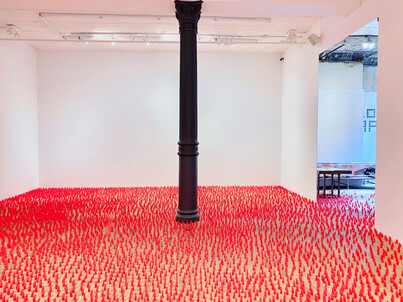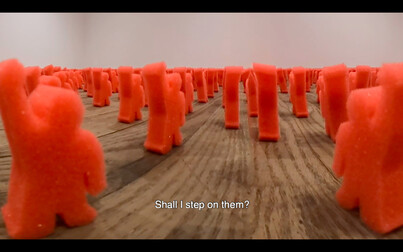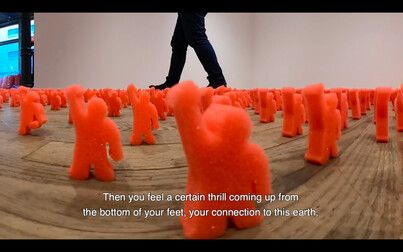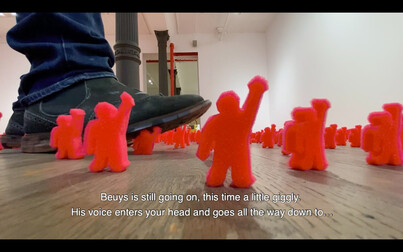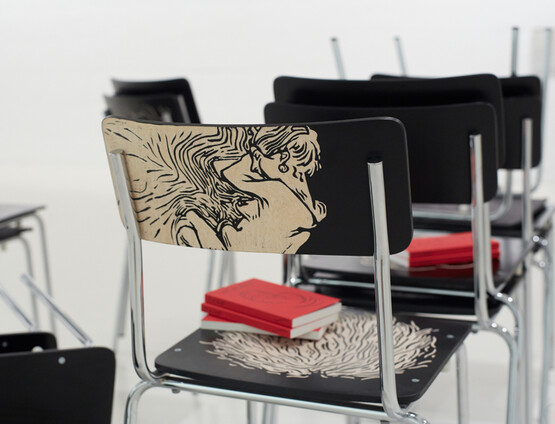
‘Experience art’ in a pandemic: Serkan Özkaya and Joseph Beuys in New York
by Julian Jason Haladyn
Reviews /
Exhibition
• 05.06.2020
The exhibition Left is Right, Down is Up at Postmasters Gallery, New York, pairs Serkan Özkaya’s installation Proletarier Aller Länder (Workers of the World) FIG.1 with a sound piece by Joseph Beuys. A multitude of near-identical small red foam figures blanket the gallery floor, a diminutive proletarier serenaded by the chanting voice of Beuys and two colleagues in a recording from 1968: ‘Ja ja ja ja ja, nee nee nee nee nee’. As visitors walk through the gallery, stepping on the work, the figures collapse under feet and spring back up once released, creating, according to the invitation, an ‘ambiguous viewing experience’. And yet the possibility of accessing this ‘experience’ was interrupted because of the COVID-19 pandemic. The show was installed as planned, but the gallery has been closed to visitors since then. In a statement titled ‘How to experience “Experience Art” in a pandemic – a modest proposal’, the gallery owner Magda Sawon writes: ‘The exhibition is now on pause, sitting still in a closed gallery’.1
This sentiment is repeated in red lettering at the top of the Postmasters website: ‘All our current exhibitions are on pause’. Left is Right, Down is Up was ‘opened’ to the public on 14th March, soon after emergency measures were issued in New York City to restrict the gathering of groups of people. Postmasters lists the show as ‘ongoing’, reflecting the uneasy sense of time initiated by the virus, of life paused interminably, dates for the reintroduction of services being pushed further and further into an unknown future. Given the necessity of a bodily engagement with Özkaya’s work – navigating the space, stepping on the foam figures – and its multi-sensory pairing with the Beuys piece, the gallery’s decision to install the show in a space knowingly closed to the public invites consideration of the role of such displays in times of crisis. In her statement, Sawon discusses the gallery’s decision to host the exhibition in a new form online:
We meant it to be a situation-specific show, a timely proposition to experience – through art – the current moment and all its discontents. Now we are trying to navigate actual/virtual terrain, go beyond known formulas, and think up ways to address the once-impossible. We are trying to translate art that is about encounter and participation, and which falls outside of merchandise presentations in an online viewing room.
In an attempt to rethink the exhibition experience online, Postmasters commissioned Özkaya, along with the cinematographer Deniz Tortum, to produce a short film that goes ‘beyond documentation’ to capture the missed experience of the exhibition. ‘Films are experience.’ ‘If you can’t see the show, see this.’
The film begins with a black screen, a caption across the bottom reads: Left is Right, Up is Down at Postmasters Gallery is open but it is not open. Beuys’s chants play over shots of the red foam workers, seen straight-on from the gallery floor, a perspective that would be hard to experience in reality. Captions of Beuys’s words appear across the bottom of the screen in English – ‘yeah yeah yeah yeah yeah, nah nah nah nah nah’ – along with intermittent descriptive captions that narrate an experience of the exhibition, defining a subjective presence addressing the relation of self and work. Starting at the front door, this narrative situates us in terms a possible encounter that includes inner questions: ‘Shall I step on them?’ FIG.2. Soon after, a man – who we later learn is Özkaya – steps his way through the field of little proletarier, walking from one side of the gallery to the other FIG.3. The film cuts to a close-up of Özkaya’s shoe as it crushes one of the abstract figures, which immediately upon its release reforms, returning to the visual mass of workers FIG.4. The scene cuts from this close-up to black, a caption appearing that communicates the issue at stake in this film: ‘How can this experience be translated?’ FIG.5.
Here we confront an important acknowledgment of the impossibility of capturing experience. The film makes no attempt to ‘document’ the show but instead creates a new work using the exhibition, translating the installation into an experience that we, the socially distant viewers, are able to participate in. We experience, here, the non-experience of the exhibition, witnessing the exhibition on pause. The film ends with an overview of the field of workers, as seen from the point of view of a person standing and looking down – ‘We froze the show at Postmasters Gallery. In time and space’. The camera pans across the expanse of the installation, eventually losing focus – proof, perhaps, of the gallery’s resilient exhaustion. Sawon has been outspoken about her belief that smaller galleries such as Postmasters will survive the pandemic and her investment in leaving Left is Right, Down is Up on display while the gallery is closed speaks to her larger commitment to the role of art in society. At a time when there is a disproportionate burden on the working classes and the uncertainty of our situation is resulting in a collective exhaustion, Özkaya’s installation, whether on display in an empty gallery or translated into film, serves as an ambiguous voice to question the current state of experience.




